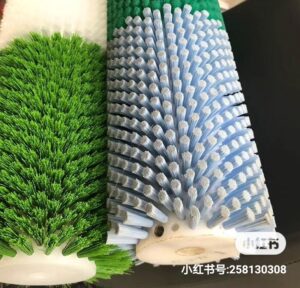When it comes to effective cleaning, having the right tools is essential. One such tool is the brush cylinder, which offers versatility and efficiency in various cleaning tasks. In this article, we will explore what a brush cylinder is, its uses, the types available, where to find them, and how to clean them.
What is a brush cylinder?
A brush cylinder, also known as a cylindrical brush, is a cylindrical-shaped cleaning tool composed of bristles or filaments that are evenly distributed around the cylinder’s circumference. The brush cylinder is commonly mounted on a shaft, allowing it to rot ate and perform a wide range of cleaning applications.
What is a cylinder brush used for?
Cylinder brushes find extensive use in different industries and applications due to their versatility. Some common uses of cylinder brushes include:
- Surface Cleaning: Brush cylinders effectively clean various surfaces, such as conveyor belts, production lines, and machinery parts, by removing dust, dirt, and debris.
- Deburring: Cylinder brushes are ideal for removing burrs and sharp edges from metal or plastic parts during manufacturing processes, ensuring a smooth and polished finish.
- Polishing: With the appropriate bristle material, brush cylinders are used for polishing and buffing applications, providing a sleek and shiny surface.
- Material Handling: Cylinder brushes facilitate the movement and transfer of materials in industrial settings, including sorting, guiding, and aligning items on conveyor belts or production lines.
Different types of brush cylinders:
- Abrasive Cylinder Brushes: These brushes are designed with abrasive filaments, such as nylon or abrasive nylon, to remove tough stains, rust, or coatings from surfaces.
- Wire Cylinder Brushes: Wire brushes are commonly used for heavy-duty cleaning tasks, such as rust removal, weld cleaning, and deburring in metalworking industries.
- Nylon Cylinder Brushes: Nylon bristles are ideal for gentle yet effective cleaning, polishing, and surface finishing applications. They are commonly used in the food industry and other sensitive environments.
Where to find Cylinder brushes?
If you are looking for high-quality and reliable cylinder brushes, cn-brushes.com is a reputable retailer that offers a wide range of brush cylinders for various applications. They provide options suitable for different industries and can assist you in finding the right brush cylinder to meet your specific cleaning needs.
How to clean a cylinder brush?
Proper cleaning of a cylinder brush ensures its longevity and optimal performance. Here’s a step-by-step guide on how to clean a cylinder brush effectively:
- Prepare the Cleaning Solution: Fill a bucket or container with warm water and add a mild detergent or cleaning solution suitable for the type of bristles on the brush cylinder.
- Remove Excess Debris: Before cleaning, gently tap or shake the brush cylinder to dislodge any loose dirt or debris.
- Soak the Brush Cylinder: Submerge the brush cylinder in the cleaning solution and let it soak for a few minutes to loosen any stubborn grime.
- Brush Cleaning: Use a brush or soft cloth to gently scrub the bristles, moving toward the bristles’ orientation. Pay close attention to any extremely soiled or unclean areas.
- Rinse Thoroughly: Rinse the brush cylinder under running water to remove all traces of the cleaning solution and debris.
- Shake off Excess Water: Gently shake the brush cylinder to remove excess water. You can also pat it with a clean towel or cloth to absorb moisture.
- Air Dry: Place the brush cylinder in a well-ventilated area or hang it with the bristles facing downwards to allow for proper air circulation and complete drying.
- Inspect and Store: Once the brush cylinder is dry, inspect it for any remaining dirt or damage. Remove any tangled or loose bristles. Store the brush cylinder clean and dry to prevent dust or moisture buildup.
FAQs
Can I use the same cleaning solution for all brush cylinders?
It is important to choose a cleaning solution appropriate for the bristle material of the brush cylinder. For example, mild detergents work well for nylon bristles, while wire brush cylinders may require a specialized cleaner. Always follow the manufacturer’s recommendations for the best cleaning results.
How often should I clean my brush cylinder?
The frequency of cleaning depends on the intensity and type of cleaning tasks performed. As a general rule, cleaning brush cylinders after each use or whenever they become visibly dirty is recommended. Their performance and lifetime are maintained and extended with regular cleaning.
What should I do if the bristles of my brush cylinder become worn or damaged?
If you Notice Significant Wear or DAMAGE to the Bristles, It is advisable to Replace the Brush Cylinder. USING A BRUSH CYLINDER WORN Bristles May Result In L ESS Effective Cleaning and Potential Damage to the Surface Being Clenet. Refer to the Manufacturer Or a ReLiable Retailer like cn-brushes.com for suitable replacement options.
Finally, A brush cylinder is a versatile and valuable tool for various cleaning applications. With different types available, you can choose the appropriate brush cylinder for your specific cleaning needs. Regular cleaning and proper maintenance will ensure its longevity and optimal per formance. By following the Provided cleaning instructions and addressing common FAQs, you can make the most of your brush cylinder and achieve efficient and effective cleaning results.

